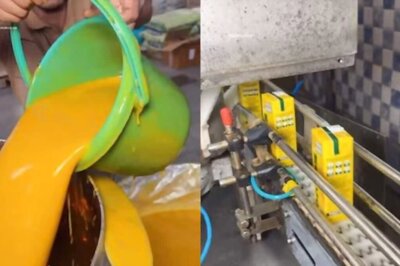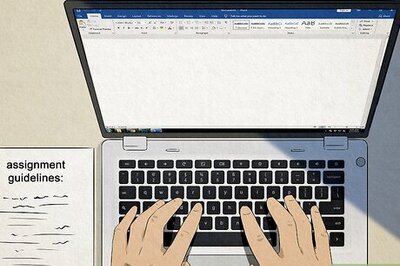
views
Quality is a genuine concern for a customer buying any product in the market. As a young child I remember accompanying my mother to the bazaar where there were some toys on sale. As is the want of children, I had sought one of those very toys only to be rebuked by the experienced lady – they are Chinese and will not last, she had prophetically said. Although this story is two decades old, nothing seems to have changed – the litany of complaints against poor-quality Chinese products continues even today. This article, however, is not about cheap, poor-quality Chinese toys but about high-end military weapons and systems where poor quality and workmanship have proved to be a bane for customers.
Nepal Airlines has found this out the hard way. The airlines has grounded six Chinese-made aircraft saying that it is proving to be unaffordable to fly them. The pilots and ground crew at Nepal Airlines, as per a Wion report, repeatedly told their management that the Chinese-made planes were causing heavy losses ever since they were acquired between 2014 and 2018, and that these should be grounded to check further losses. These sub-standard planes required heavy maintenance with extremely poor serviceability rates. Finally, in 2020, nearly six years after the first batch landed in Kathmandu, the board of Nepal Airlines took the decision to ground these planes.
Of the six planes, two were given as grant by the Chinese Communist Party (CCP) and four were bought in a government-to-government deal. The airline is finding it extremely difficult to repay the loan as these planes have not yielded the expected return on investment. To compound the problems of the Nepalese national carrier, even as the planes are grounded, the airline has to still clear dues worth $35.1 million to the Nepal Finance Ministry which, in turn, is repaying the CCP loan at a steep 1.5 per cent interest along with a service charge and management expenses amounting to 0.4 per cent of the overall loan amount.
Can there be other examples of poor-quality products which add to the debt-trap laid by the CCP? The answer lies in the affirmative. The issues highlighted in Nepal are certainly not a unique case. Close partners of China including Myanmar and Bangladesh have also expressed concerns over the abysmal quality of Chinese-made military equipment. Beijing gifted two 1970s-era Ming class Type 035G submarines to Bangladesh valued at $100 million each in 2017, which were re-inducted as BNS Nobojatra and BNS Joyjatra. Both the submarines are lying idle due to technical issues. The year 2020 saw the Chinese gifting Dhaka the Wuhan virus and in addition two Chinese 053H3 Frigates – BNS Umar Farooq and BNS Abu Ubaidah. But these ships too have been encountering problems like non-functioning navigation radars and gun systems. The Myanmar forces have also raised numerous complaints regarding Chinese equipment.
Is this a problem faced only in South Asia? No, it is a worldwide phenomenon. Kenya purchased VN-4 armoured personnel carriers manufactured by Chinese government-owned Chongqing Tiema Industries in 2016. But China’s sales representative themselves declined to sit inside the vehicles during a test firing. A few Kenyan personnel have died in those vehicles.
Algeria also saw a number of accidents involving Chinese CH-4B UCAV drones. The first accident took place in 2013 near Algeria’s Tindouf airbase; second near the Ain Oussera airbase; and third near Bir Rogaa airbase. Jordan, in West Asia, had purchased six of the same Chinese CH-4B UCAVs in 2016, but by June 2019, the country had decided to sell them off.
But certainly, iron-brother Pakistan would have had no problems with Chinese military equipment. Nothing can be further from the truth. Defective military equipment supplied by China has been the bane of the Pakistan armed forces, which have been used to superior quality products made in the West including F-16 fighters, P3C Orion patrol aircraft and the British-made Type 21 warships.
The Chinese-made Wing Loong II Unmanned Aerial Systems (UCAVs) have been grounded due to crippling defects within days of induction into the Pakistan Air Force. The Pakistan Air Force’s misery has been compounded by the pathetic service and maintenance provided by the Chinese firm. The China National Aero-technology Import and Export Corporation has so far been indifferent to desperate calls for repair and maintenance of the grounded drones. A similar story emerges with the joint production of JF-17 fighters.
According to China’s state media narrative, the country’s modern aircraft are the best in the world. Yet Pakistan’s experience with the Chinese-made JF-17 tells a different story. The PAF has brought over 100 JF-17 Block Is and Block IIs into active service. As per reports, approximately 40 aircraft are not airworthy due to shortage of spare parts. The Russian-made RD-93 engine of the JF-17 has reportedly experienced frequent cracks in guide vanes, exhaust nozzles, and flame stabilisers. The Chinese are trying to replace the RD-93 with the Chinese made WS-13 engines. When these will be made available to Pakistan remains the moot issue. Pakistan has expended more than $3 billion on acquiring these 3.5 generation fighters. Whether this expenditure was truly worthwhile, is a question Pakistani taxpayers must ask.
Similar is the case with the SAM (surface-to-air missile) system on the Zulfiqar-class frigate procured through a multi-million-dollar loan from the Chinese EXIM Bank. The system – itself a clone of the French Crotale system – has been plagued with serviceability issues leading to the Pakistani Navy turning to European suppliers for future inductions.
This certainly is just the tip of the iceberg. Many nations unable to acquire expensive military tech from other reliable sources procure seemingly inexpensive weapons and systems from the Chinese market. They, at their own peril, do not factor the life cycle costs and reliability factors of Chinese products. The Chinese continue to use financial inducements, including easily available loans, to sell their products.
The story continues, as famous French writer Jean-Baptiste Alphonse Karr says, “plus ça change, plus c’est la même chose” – the more things change, the more they stay the same.
Aditya Raj Kaul is Contributing Editor with more than a decade-long experience in covering Conflict, Foreign Policy and Internal Security.
Read all the Latest Opinions here




















Comments
0 comment